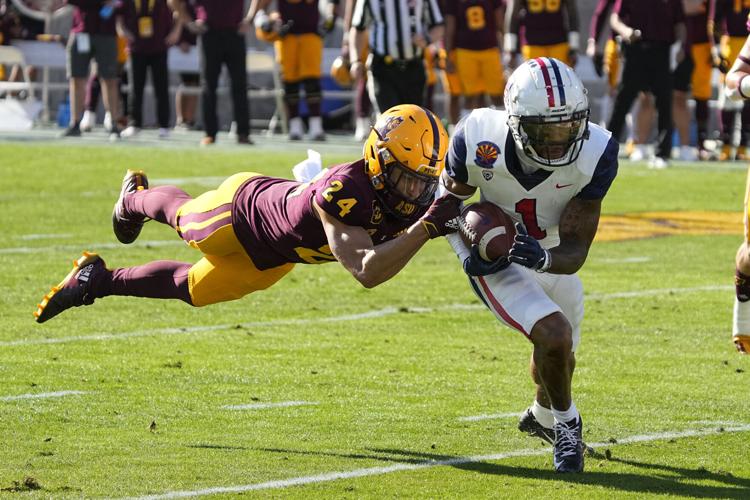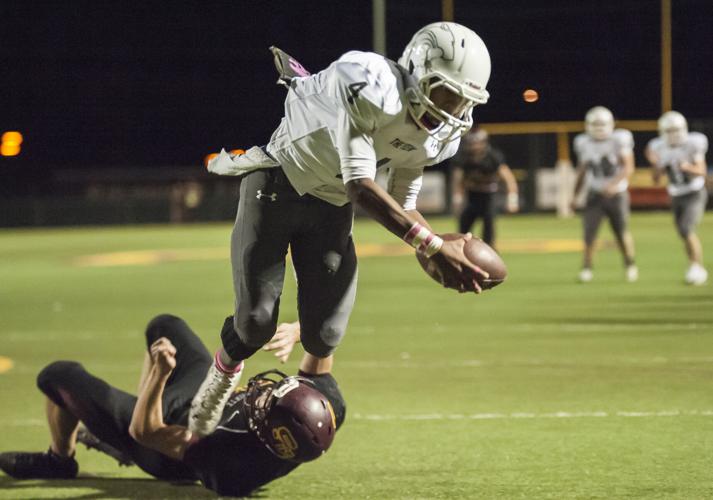Stanley Berryhill III is preparing for an NFL draft for the first time. But in a sense, he’s been here before.
Overlooked. Underestimated. Disrespected. It’s the story of Berryhill’s athletic life.
“Having to prove myself,” the Tucson product said. “Having to prove myself again. Having to prove myself over and over again.”
Berryhill had zero scholarship offers coming out of high school. His hometown school — his dream school — wouldn’t give him the time of day.
A family friend helped him get a walk-on opportunity at Arizona. A little over a year later, Berryhill earned a scholarship. It took multiple seasons to earn a starring role. Now he’s set to play in Thursday’s East-West Shrine Bowl.
The game is another opportunity to showcase his skills after a week of interviews and practices. “A lot of first impressions,” Berryhill said.
The wide receiver who finished second in the Pac-12 with 83 catches has made a positive impression so far, according to multiple accounts. But his personal narrative hasn’t changed, and it probably never will.
“For the majority of my life, I’ve been the underdog,” Berryhill said. “I have no problem doing it again. It just is what it is.”
The early projections have Berryhill as a late-round draft pick at best. ESPN’s Scouts Inc. currently ranks 316 prospects. Berryhill isn’t one of them. Last year’s draft had 259 selections.
Berryhill gets it. He’s never been the biggest or the fastest. He checked in for the East-West Shrine Bowl at 5 feet 9 3/8 inches. He’s the third shortest among 16 participating wideouts.
But slights, whether real or perceived, can motivate a man. The just-retired Tom Brady never forgot that 198 players, including six quarterbacks, were taken ahead of him in the 2000 draft.
So as Berryhill prepares to take the field at Allegiant Stadium in Las Vegas, the same motivational mantra he’s had since he was a kid will be running through his head:
“How do you make skeptics believers?”

Stanley Berryhill III played at Mountain View High School before transferring to a school in Southern California for his senior season.
From Falcons to Wildcats
Was Berryhill treated differently than any other 8-year-old on the Tucson Falcons youth football team? Probably not. That doesn’t mean he enjoyed playing between eight and 10 snaps per game his first year. “The minimum that every player had to play,” Berryhill noted.
His father and trainer, also named Stanley, advised him to take advantage of the few opportunities he got.
“They don’t believe in you,” the elder Berryhill told his son. “You’re going to run the ball twice a game. In order for you to prove yourself, you’re gonna have to score a touchdown.”
“You had to be tough,” the elder Berryhill recalled this week. “You had to earn your stripes.
“That competitive atmosphere really groomed the kids for what they were in store for.”
The younger Berryhill would excel in football and baseball at Mountain View High School. He averaged 21.5 yards per catch and scored 16 touchdowns in 17 games over his sophomore and junior seasons.
He had Division I offers to play baseball. Football? Crickets.
Berryhill’s father discussed his son’s plight with former college teammate Matthew Hatchette, who at the time was the offensive coordinator at Orange Lutheran High School in Orange, California. Orange Lutheran is a member of the highly competitive Trinity League. Hatchette had an idea: What if Berryhill transferred there for his senior season?
The goal was to raise his profile. Surely, if Berryhill produced in one of the top high school conferences in the country, college coaches would take notice.
Berryhill did produce, catching 63 passes for 961 yards and nine touchdowns. College coaches didn’t take notice. Berryhill still didn’t have any Division I scholarship offers.
“Schools were telling me that they liked me a lot,” he said. “If they don’t get this kid, then I’ll have a scholarship. Just my luck, every team got the player that they wanted.”
The best Berryhill could do was a preferred walk-on offer from Arizona State. He accepted it — but still wanted to go to Arizona.
“We were bitter,” Berryhill’s father conceded.
Charlie McKee —a former UA receiver who had trained the elder Berryhill, a star running back at Cholla High School — showed Berryhill’s film to then-Wildcats coach Rich Rodriguez. Rodriguez liked what he saw and offered Berryhill a walk-on spot. He ended up where he had hoped to be all along.
Changes and chances
It didn’t take long for Rodriguez’s successor, Kevin Sumlin, to recognize that Berryhill belonged. Sumlin, who took over the program in January 2018, gave Berryhill his long-coveted scholarship in August of that year.
After serving as a productive role player that season and the next, Berryhill emerged as Arizona’s leading receiver during the pandemic-shortened 2020 campaign. Then Sumlin was fired, and a period of uncertainty followed.
Unsure where the program was headed, Berryhill decided to put his name in the NCAA transfer portal. Maybe this would be his chance to shed the underdog label. Even if he transferred to a Group of Five school, he could be a go-to guy.
The elder Berryhill supported his son but wasn’t sure it was the right move.
“What if this is your story?” the elder Berryhill wondered. “Being an underdog ... you have to embrace it. It will get you where you want to go.”
Ball State and Louisiana Tech showed considerable interest. Berryhill committed to Ball State.
A few days earlier, Arizona had hired Jedd Fisch. One of his first tasks was try change the minds of Berryhill and a handful of other receivers who had entered the portal.
Fisch and new receivers coach Kevin Cummings told Berryhill they would set him up for success — that performances like his eight-catch, 70-yard, one-TD outing vs. USC in the 2020 opener could become the norm.
Fisch also made Berryhill a promise.
“Just give him the spring semester,” Berryhill said. “And if I don’t like it, he’ll help me find a school to go play at. Give him a chance.”
If anyone could relate to that message, it was Berryhill. That’s all he ever wanted.

Arizona wide receiver Stanley Berryhill III runs away from Arizona State defensive back Chase Lucas during the teams' rivalry game in November.
Gunning for a spot
Berryhill returned to Arizona. He became one of two players to earn the No. 1 jersey, a reward for all-around offseason excellence.
Berryhill led Arizona in receiving and total yards and made first-team All-Pac-12 as an all-purpose player. He made sure the league’s coaches noticed him by going above and beyond, contributing not only on offense but on special teams.
Berryhill served as the Wildcats’ primary punt returner and their best punt gunner. The latter wasn’t something he had to do; it was something he wanted to do.
“My whole college career I’ve been asking,” Berryhill said. “I know that playing special teams ... is how I’m going to get to the NFL.”
Former Wildcats Dane Cruikshank, Demetrius Flannigan-Fowles and Gary Brightwell landed NFL roster spots largely because they were willing and able to play special teams. Cruikshank (fifth round) and Brightwell (sixth) were third-day draft picks; Flannigan-Fowles was an undrafted free agent.
If Berryhill gets drafted, he’ll join an exclusive club. The last Tucsonan to play for Arizona and get picked in the NFL draft was running back Ka’Deem Carey in 2014.
“It would be a big deal,” Berryhill said. “Putting Tucson on the map and showing everyone in the world that Tucson has ballers out here.”
And if it doesn’t happen? If Berryhill has to make it as a UDFA like his longtime friend Flannigan-Fowles?
That would be OK too. It might even be fitting.







